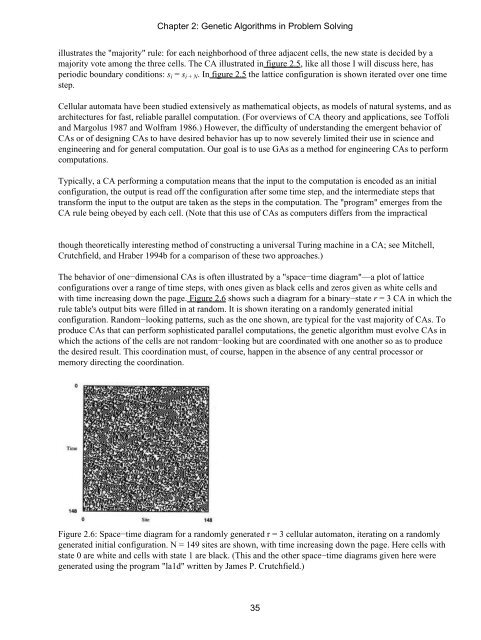An Introduction to Genetic Algorithms - Boente
An Introduction to Genetic Algorithms - Boente
An Introduction to Genetic Algorithms - Boente
Create successful ePaper yourself
Turn your PDF publications into a flip-book with our unique Google optimized e-Paper software.
Chapter 2: <strong>Genetic</strong> <strong>Algorithms</strong> in Problem Solving<br />
illustrates the "majority" rule: for each neighborhood of three adjacent cells, the new state is decided by a<br />
majority vote among the three cells. The CA illustrated in figure 2.5, like all those I will discuss here, has<br />
periodic boundary conditions: si = si + N. In figure 2.5 the lattice configuration is shown iterated over one time<br />
step.<br />
Cellular au<strong>to</strong>mata have been studied extensively as mathematical objects, as models of natural systems, and as<br />
architectures for fast, reliable parallel computation. (For overviews of CA theory and applications, see Toffoli<br />
and Margolus 1987 and Wolfram 1986.) However, the difficulty of understanding the emergent behavior of<br />
CAs or of designing CAs <strong>to</strong> have desired behavior has up <strong>to</strong> now severely limited their use in science and<br />
engineering and for general computation. Our goal is <strong>to</strong> use GAs as a method for engineering CAs <strong>to</strong> perform<br />
computations.<br />
Typically, a CA performing a computation means that the input <strong>to</strong> the computation is encoded as an initial<br />
configuration, the output is read off the configuration after some time step, and the intermediate steps that<br />
transform the input <strong>to</strong> the output are taken as the steps in the computation. The "program" emerges from the<br />
CA rule being obeyed by each cell. (Note that this use of CAs as computers differs from the impractical<br />
though theoretically interesting method of constructing a universal Turing machine in a CA; see Mitchell,<br />
Crutchfield, and Hraber 1994b for a comparison of these two approaches.)<br />
The behavior of one−dimensional CAs is often illustrated by a "space−time diagram"—a plot of lattice<br />
configurations over a range of time steps, with ones given as black cells and zeros given as white cells and<br />
with time increasing down the page. Figure 2.6 shows such a diagram for a binary−state r = 3 CA in which the<br />
rule table's output bits were filled in at random. It is shown iterating on a randomly generated initial<br />
configuration. Random−looking patterns, such as the one shown, are typical for the vast majority of CAs. To<br />
produce CAs that can perform sophisticated parallel computations, the genetic algorithm must evolve CAs in<br />
which the actions of the cells are not random−looking but are coordinated with one another so as <strong>to</strong> produce<br />
the desired result. This coordination must, of course, happen in the absence of any central processor or<br />
memory directing the coordination.<br />
Figure 2.6: Space−time diagram for a randomly generated r = 3 cellular au<strong>to</strong>ma<strong>to</strong>n, iterating on a randomly<br />
generated initial configuration. N = 149 sites are shown, with time increasing down the page. Here cells with<br />
state 0 are white and cells with state 1 are black. (This and the other space−time diagrams given here were<br />
generated using the program "la1d" written by James P. Crutchfield.)<br />
35






